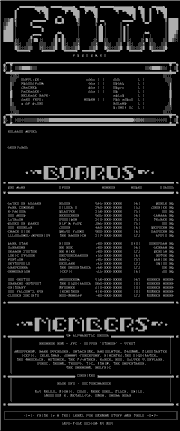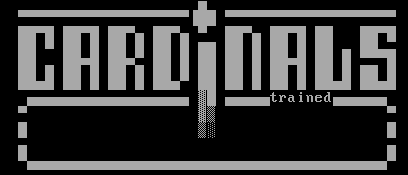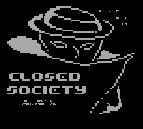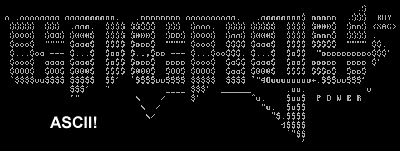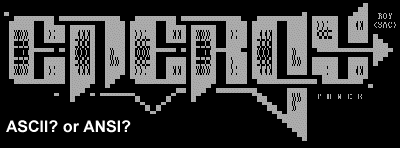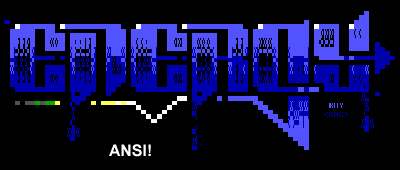Table of Contents
The Wikipedia article about ASCII art is very good. I contributed to it a lot myself and provides a good historic background to the subject. I recommend to you to read it as well. I also posted a video at my blog, which is about 1 hour long and shows a presentation by RaD Man, a fellow ASCII/ANSI artist where he shows the historic development of text art in general and also some great examples of ancient and modern types of text art. This article focuses on the ASCII and ANSI text art produced by the underground art scene on the PC and Amiga since the beginning of the 1990s. ASCII art and even more so "text art" is much older than that, but not subject to this article of mine. What is ASCII art?ASCII art, an artistic medium relying primarily on computers for presentation, consists of pictures pieced together from the 95 printable characters defined by ASCII. The term is also used more loosely to refer to text based art in general. They can be created with any text editor, and are often used with free-form languages. Most examples of ASCII art require a fixed-width font (non-proportional fonts, like on a traditional typewriter) such as Courier for presentation. I wrote an article about the three Styles of the Underground Text Art Scene which explains things in much more detail and is also supported by real ASCII Examples to illustrate the Styles and their differences. It also addresses the Issues with "Block" ASCII and ANSI under Windows and what you can do. ASCII art might be a product of the modern age, which came with the invention of the computer, but text art, what ASCII art essentially is, preceeds modern ASCII art by hundreds, if not thousands of years. Christian Wirth aka RaD Man, founder of the PC Text art group ACiD (ANSI Creators in Demand) did a presentation called "The Art of Textmode - History of Text Art and the Computer ASCII Art Scene" at the Assembly Demo Party August 5th-8th, 2004 at the Hartwall Areena in Helsinki, Finland. I posted the video at my blog. The presentation is about 1 hour long and covers the early forms of text art starting at the ancient Rome, to Typewriter art, Radio Teletype or RTTY, Atari ATASCII art and C-64 PETSCII art to Amiga 500+ Oldskool art and PC Block or High ASCII art and Newskool. The climax is the presentation of some impressive Textmode demos that are of relative young age (2002 and later). "NFO" File ASCII Art
NFO Files with ASCII Logo headers are still in use today. Do you want to see an old one? Here is a complete "FAiTH" NFO file, which I created in 1993. "Faith" was a German cracker group for games who was at that time already a subsidiary of the legendary cracking and demo group TRSI (Tristar and Red Sector Inc.). File_ID.diz ASCII ArtThe file_id.diz (an actual file with this name) is a plain text file containing a brief content description of the archive in which it is included. The extension "DIZ" stands for "Description In Zipfile". Zipfile, because ZIP (pkzip now Winzip) was the defacto standard for files transfered through bulletin board systems on the IBM PC. Even if an archive was compressed with another tool, such as ARJ, RAR or ACE, was it afterwards included in a Zip-file (which did in those cases increase the file size rather than compress it, because it was compressed already). The file_id.diz standard was pioneered by Clark Development Company (CDC) and supported by their BBS software PCBoard. What it did, was after a file was uploaded to a BBS and tested (if configured by the sysop), was the following. The file processing tool running on the BBS was grabbing the file_id.diz content (if it existed) and automatically used the content for the file description in the boards file listing. I started using bulletin board systems before the file_id.diz standard existed. It was a pain in the a**, trust me on that. You had to enter for every single file, which you uploaded, a description manually. That was not only causing a lot of headaches for the user who uploaded files, but also for the sysops, because incorrect or missing descriptions were often the result of this. Either was the description entered incorrectly by the user or the user disconnected from the BBS after an upload without waiting to enter the description for the uploaded files. What the file_id.diz also allowed for the first time, was the use of small logos for the file description. Those were several lines long and unthinkable to type in by hand every time. Small ASCII Logos for file descriptions were used on the Commodore AMIGA before the file_id.diz standard was developed on the PC. AMIGA users had tools on the user side (terminal software) to easily extract and manually copy and paste descriptions from files. The AMIGA was capable of real multi-tasking, something the PC was unable to do at that time.
I have to give credits to myself (without the ability to provide verifyable proof), that I was the first one who created a Block ASCII file_id for any group. It was the file_id.diz for the trainer/hacks group Cardinals, which Ufonaut and I founded in the Summer of 1992. The Cardinals releases stood out in the BBS file listings, because Block ASCII is much more prominent than the "outlined" looking AMIGA-style logos, which were used by all other groups at that time. Unfortunately did it not take very long until other groups adopted the use of block ASCII for their file_id's. ASCII art for Ads?
The "Prime" of ANSI Art & ASCII ArtThe "prime" of ASCII and ANSI art (and also of my art group SAC) was during a time prior the general availability of the Internet, when most communication within the Scene (Warez and Demoscene) was done via so called Mailbox Systems (BBS - Bulletin Board System). Modems were used to call the phone number(s) of the Mailbox System directly (not an ISP). On the other end of the phone line was simply another computer with BBS Software running and Modem(s) waiting for incoming calls. During the time when ANSI art blossomed (around 1991 and forward) were modems not as fast as the standard modems of today, which have a speed of 52KBits. The "fast" modems had a speed of 14.4KBits, also 9.6KBit and 2400 "Baud" modems were in wide spread use. Long ANSIs took some time to load, in some cases even minutes. Some artists even considered this in their artwork and created sections with less characters that load fast followed by sections that use a lot of characters that load slower. ANSI animations also considered the speed issue for timing purposes. Block/High ASCII ControversyIt happens again and again that somebody comes along to say that the PC Block/High ASCIIs are not ASCIIs, but ANSIs.
I picked the examples on purpose to illustrate the dillema and to make a point to anybody who says that the logo in Example 2 is an ANSI and not an ASCII. A Message to the Guys Who Say That Block ASCIIs Are NOT ASCIIs:For you it might be an ANSI, but I am a MS DOS PC user since 1991 and any text that did not require the ANSI.sys driver loaded to be displayed properly was an ASCII*1. The stuff that required the ANSI.sys driver on the other hand (to interprete the "Escape" coding for cursor movements and colors), is for me as it is for you, an ANSI. *1 ASCII as in Text art and Code Page 437 or me in Europe Code Page 850 and NOT ASCII as in American Standard Code for Information Interchange, specifically US-ASCII or ISO 646 Regarding Jason Scott (BBS - The Documentary) saying that it is not ASCII: F**k Jason :) He is just a journalist (with a bad collecting habit hehe). Just kidding, Jason is a good guy, but in this case he is wrong. I don't know who got the wrong idea into his head, but it is on my to-do list to change that. Technically is ANSI also the wrong term for Block ASCII or High ASCII, because those things have nothing to do with the ANSI standard nor the ANSI.sys. They are called "High ASCII" or "Black ASCII" for reason of simplicity by the people who are not a fan of cryptic number and letter combinations like "ISO 646"", what would be more precise when you refer to the alpha numeric, number and special characters on the computer. "ISO 646" is the standard that defines them, ASCII is the organization who designed the standard. A correct name for "Block/High ASCII" would be CP437 (which was there first and graphical characters are the same as the European CP850 or CP858). It did not happen that way. People call things whatever they want. If they call duct tape "duck tape", cola "coca cola" / "coke" or a paper tissue "tempo", then there is nothing a single person can do about it. I hope that settles this depate once and for all! Back to ASCII Art Academy ASCII Art Articles and Tutorials
ASCII Art and other Text Art by Various Artists
|
|

